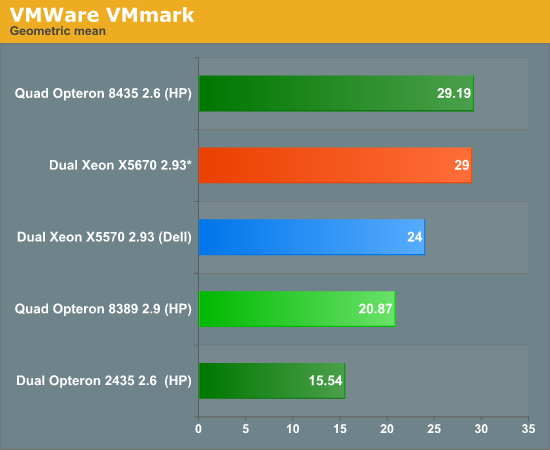The Intel Xeon 5670: Six Improved Cores
by Johan De Gelas on March 16, 2010 3:39 PM EST- Posted in
- IT Computing
Virtualization & consolidation
VMmark - which we discussed in great detail here - tries to measure typical consolidation workloads: a combination of a light mail server, database, fileserver, and website with a somewhat heavier java application. One VM is just sitting idle, representative of workloads that have to be online but which perform very little work (for example, a domain controller). In short, VMmark goes for the scenario where you want to consolidate lots and lots of smaller apps on one physical server.

(*) preliminary benchmark data
VMmark is another completely Intel dominated benchmark. One six-core Xeon 2.93 is worth two six-core Opterons at 2.6 GHz. It is important to emphasize that we are talking about benchmark which runs up to 120 VMs, so this benchmark might be influenced greatly by VM exit and entry times. So let us take a look at our own virtualization benchmarks with fewer VM to hypervisor transitions.










40 Comments
View All Comments
yinan - Tuesday, March 16, 2010 - link
Bah 6 cores. 8 sockets by 8 cores is where it is at :)landerf - Tuesday, March 16, 2010 - link
I always wish with these server/workstation part reviews that we could get a gaming page just for kicks. Specifically in this case I'm thinking of the upcoming dual socket EVGA board and if it will have any effect on games or if it will be only synthetics that show a benefit. I'd also like to see a modern workstation card vs it's mainstream counterpart to see if the gaming performance gap has gotten smaller or larger over the years. I think recently there's been a push to make workstation cards do better in 3d games so you can test your work on the same rig, cutting back on the number of systems.GeorgeH - Tuesday, March 16, 2010 - link
I'd also be curious to see the E5620 overclocked in a consumer board, as its ~$400 price fills the hole between the ~$300 i7-920/930 and the ~$600 i7-950 rather nicely.Intel's PR people would probably get pissed, but screw 'em.
jonup - Tuesday, March 16, 2010 - link
I was about to post the same. There is a lot of people using Xeons in X58 and P55 boards. Some prefer the lower power consumption others beleive the Xeons oc better. Please show us the money!DigitalFreak - Tuesday, March 16, 2010 - link
You do realize that the 55xx/56xx series Xeons only work in dual socket motherboards?!?GeorgeH - Tuesday, March 16, 2010 - link
I think you've got that backwards. A dual socket motherboard needs 5-series chips, but a 5-series should work in a single socket board just fine. In general it'd be silly to run only one (a 2.66GHz W3520 costs ~$300 while a 2.66GHz X5550 costs ~$1000) but if the cheapest 32nm LGA-1366 chip is a 5-series Xeon it might be worth it.jonup - Wednesday, March 17, 2010 - link
But you can get E5520 @2.26GHz for $390 and get a faster QPI.greylica - Tuesday, March 16, 2010 - link
Blender 3D 2.50 in his Alpha 2 Stage supports 64 simultaneous Threads, and it's not hard to make benchmarks, and I am missing Blender 3D benchmarks in every processor launch, what happened with ''Blender 3D Character benchamrks'' ?Blender can extract blood from those ''beasts''...
JohanAnandtech - Wednesday, March 17, 2010 - link
I have indeed heard more than once that Blender is getting really popular. "Alpha 2" does not sound like the software is very stable. Any suggestion to what kind of scene I should use? The scene choice is very important as the parallel rendering part must be long enough compared to some of serial parts in the process. You can mail me at johan@anandtech.com if you like. I am open to suggestions.MySchizoBuddy - Tuesday, March 16, 2010 - link
Also add HPC related benchmarks